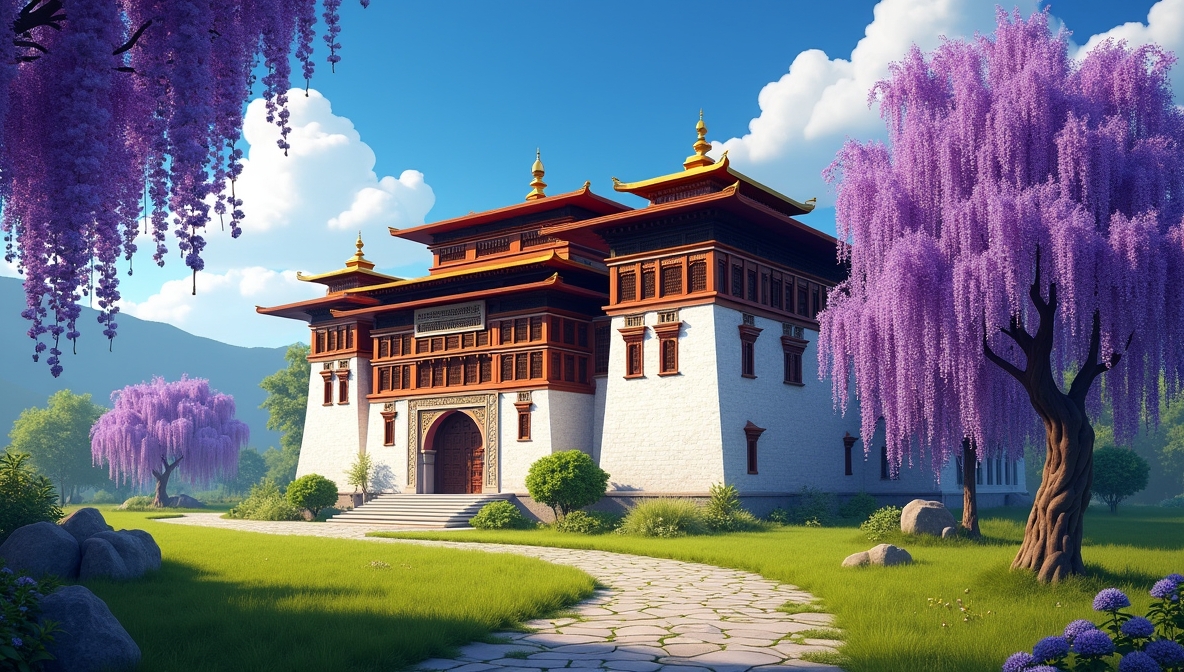Overview
Nestled at the confluence of the Pho Chhu (Male River) and Mo Chhu (Female River), Punakha Dzong, also known as Pungtang Dechen Photrang Dzong or “The Palace of Great Bliss,” stands as a testament to Bhutan’s rich cultural and historical heritage. Constructed in 1637 by Zhabdrung Ngawang Namgyal, the unifier of Bhutan, this majestic fortress served as the country’s administrative center and the seat of the government until 1955, when the capital was moved to Thimphu. Today, it remains the winter residence of the Central Monastic Body and holds significant religious and political importance in Bhutan.
Punakha Dzong is renowned for its stunning Bhutanese architecture, featuring towering whitewashed walls, intricate woodwork, and golden spires. Surrounded by lilac-colored jacaranda trees that bloom in spring, the dzong offers a picturesque setting that captivates visitors. Its strategic location and historical significance make it a must-visit destination for travelers seeking to immerse themselves in Bhutan’s unique culture and history.


Quick Facts
Location: Punakha District, Bhutan
Altitude: Approximately 1,200 meters (3,900 feet) above sea level
Established: 1637
Founder: Zhabdrung Ngawang Namgyal
Significance: Second oldest and second largest dzong in Bhutan; former capital and seat of government until 1955
Best Time to Visit: March to May (spring) and September to November (autumn)
Entry Fee: Included in the Sustainable Development Fee (SDF) for international tourists
Budget Breakdown
Traveling to Punakha Dzong can be tailored to various budgets. Below is an approximate daily budget for a mid-range traveler:
| Expense Category | Cost (BTN) | Cost (USD) |
|---|---|---|
| Accommodation (3-star) | 3,500 | 42 |
| Meals (per day) | 1,500 | 18 |
| Transportation (local) | 1,000 | 12 |
| Entry Fees & Permits | Included in SDF | Included in SDF |
| Guide Services | 2,000 | 24 |
| Miscellaneous | 1,000 | 12 |
| Total (per day) | 9,000 | 108 |
Note: The Sustainable Development Fee (SDF) is USD 200 per day for international tourists, which includes accommodation, meals, transportation, guide services, and entry fees. Regional tourists (from India, Bangladesh, and the Maldives) have different fee structures.
Flights
The primary international gateway to Bhutan is Paro International Airport (PBH). Major airlines operating flights to Paro include Druk Air and Bhutan Airlines, with connections from cities like Delhi, Kolkata, Bangkok, Kathmandu, and Singapore.
Flight Duration:
Delhi to Paro: ~2 hours
Bangkok to Paro: ~3 hours
Approximate Round-Trip Cost:
From Delhi: USD 500–700
From Bangkok: USD 600–800
Note: Prices vary based on season and booking time.
Safety
Bhutan is considered one of the safest countries for travelers. However, here are some tips to ensure a smooth trip:
Health: No mandatory vaccinations, but it’s advisable to be up-to-date on routine vaccines.
Altitude: Punakha is at a lower altitude compared to other Bhutanese destinations, reducing the risk of altitude sickness.
Local Customs: Dress modestly, especially when visiting religious sites.
Travel Insurance: Recommended to cover medical emergencies and trip cancellations.
Climate
Punakha enjoys a subtropical climate, making it warmer than other parts of Bhutan.
Spring (March–May): Pleasant temperatures (15°C–25°C); ideal for sightseeing and witnessing jacaranda blooms.
Summer (June–August): Monsoon season with heavy rainfall; travel can be challenging.
Autumn (September–November): Clear skies and mild temperatures; excellent for trekking and festivals.
Winter (December–February): Cool temperatures (5°C–15°C); fewer tourists and serene landscapes.
Best Things to Do in Punakha Dzong
1. Punakha Dzong
Explore the architectural marvel of Punakha Dzong, adorned with intricate woodwork and murals. Attend the Punakha Tshechu festival if visiting in February or March.
2. Punakha Suspension Bridge
Walk across one of Bhutan’s longest suspension bridges, offering panoramic views of the river and valley.
3. Khamsum Yulley Namgyal Chorten
Hike through rice fields to reach this stunning chorten, built to ward off evil spirits and bring peace.
4. Chimi Lhakhang (Fertility Temple)
Visit the temple dedicated to Lama Drukpa Kunley, known for its unique fertility blessings.
5. Dochula Pass
En route to Punakha, stop at Dochula Pass to view the 108 memorial chortens and panoramic Himalayan vistas.
Punakha Dzong Travel Guide
Visa Requirements: All international tourists (except from India, Bangladesh, and the Maldives) require a visa, arranged through a licensed Bhutanese tour operator.
Sustainable Development Fee (SDF): USD 200 per day for international tourists, covering accommodation, meals, transportation, guide services, and entry fees.
Best Time to Visit: Spring (March–May) and Autumn (September–November) for pleasant weather and festivals.
Local Etiquette: Always ask for permission before taking photographs of people or religious sites.
Currency: Bhutanese Ngultrum (BTN); Indian Rupee is also accepted.
Top Attractions in Punakha Dzong
Punakha Dzong: Architectural masterpiece and historical center.
Khamsum Yulley Namgyal Chorten: Spiritual monument with scenic hikes.
Chimi Lhakhang: Unique fertility temple with rich legends.
Punakha Suspension Bridge: Thrilling walk with stunning views.
Dochula Pass: Scenic spot with memorial chortens and mountain views.
Sangchhen Dorji Lhuendrup Nunnery: Peaceful nunnery offering meditation sessions.
Ritsha Village: Traditional Bhutanese village known for rice cultivation.

